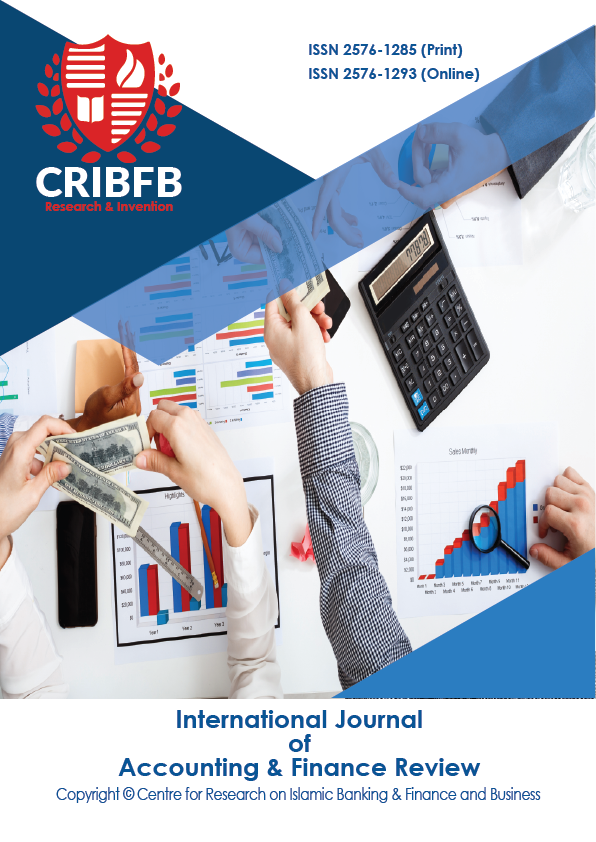IMPACTS OF EARNINGS MANAGEMENT ON CORPORATE FAILURE: A CASE STUDY OF WIRECARD
Main Article Content
Abstract
The purpose of this study is to find out whether earnings management has impacts on bankruptcy risk based on the data of Wirecard Company. The M-score of Beneish's (1999) model has been used to detect the probability of earnings management. On the other hand, the Z"-Score of Altman's (1968) model has been applied to detect Corporate Failure. Both the models are widely used models in their respective fields. The data from 2002 to 2019 were collected from the annual reports of the Wirecard Company. The result of M-Score indicates that earnings management has a significant impact on the corporate failure (Z-Score) of the company. This finding specifies that a financially distressed firm adopts earnings manipulations. The finding also implies that earnings manipulations harm the financial health of a firm. According to the findings, it can be suggested that to know the financial aspects of a company, both the (Beneish M-model and Altman Z-score model) models could be used concurrently. Beneish M-model is for detecting earnings management and the Altman Z-score model is for determining corporate failure. The novelty of the study is that no study was done on Wirecard Company focusing on the association between earnings management & bankruptcy risk.
JEL Classification Codes: G01, G32, G33, M41.
Downloads
Article Details
Section
How to Cite
References
Agrawal, K., & Chatterjee, C. (2015). Earnings Management and Financial Distress: Evidence from India. Global Business Review, 16(5), 140S–154S. http://dx.doi.org/10.1177/0972150915601928
Agustia, D., Muhammad, N. P. A., & Permatasari, Y. (2020). Earnings management, business strategy, and bankruptcy risk: evidence from Indonesia. Heliyon, 6(2), e03317. http://dx.doi.org/10.1016/j.heliyon.2020.e03317
Aharony, J., Lee, C.W. J., & Wong, T. J. (2000). Financial Packaging of IPO Firms in China. Journal of Accounting Research, 38(1), 103. http://dx.doi.org/10.2307/2672924
Alhadab, M.M., & Al-Own, B. (2017). Earnings Management and Banks Performance: Evidence from Europe. International Journal of Academic Research in Accounting, Finance and Management Sciences, 7(4), 134–145. http://dx.doi.org/10.6007/IJARAFMS/v7-i4/3444
Altman, E. I. (1968). Financial ratios, discriminant analysis and the prediction of corporate bankruptcy. The Journal of Finance, 23(4), 589-609.
Altman, E. I. (1993). Corporate Financial Distress and Bankruptcy: A Complete Guide to Predicting and Avoiding Distress and Profiting from Bankruptcy, New York: Wiley.
Altman, E. I., Hotchkiss, E., & Wang, W. (2019). Corporate Financial Distress, Restructuring, and Bankruptcy, pp. 1–20, Hoboken, New Jersey, United States: John Wiley & Sons, Inc. https://doi.org/10.1002/9781119541929.ch1
Beneish, M. D. (1999). The Detection of Earnings Manipulation. Financial Analysts Journal, 55(5), 24–36. http://dx.doi.org/10.2469/faj.v55.n5.2296
Beneish, M. D., Lee, C. M. C., & Nichols, D. C. (2013). Earnings Manipulation and Expected Returns. Financial Analysts Journal, 69(2). http://dx.doi.org/10.2469/faj.v69.n2.1
Burgstahler, D., & Eames, M. (2006). Management of Earnings and Analysts’ Forecasts to Achieve Zero and Small Positive Earnings Surprises. Journal of Business Finance Accounting, 33(5-6), 633–652. http://dx.doi.org/10.1111/j.1468-5957.2006.00630.x
Campa, D., & Camacho-Miñano, M. D. M. (2014). Earnings management among bankrupt non-listed firms: evidence from Spain. Spanish Journal of Finance and Accounting/Revista Espanola de Financiacion y Contabilidad, 43(1), 3-20. http://dx.doi.org/10.1080/02102412.2014.890820
Campa, D., & Miñano, M. D. M. C. (2013). Opportunistic earnings manipulation among bankrupt unlisted firms-How and when they do that-[Manipulación de resultados oportunista entre empresas en concurso no cotizadas–cómo y cuando lo hacen-] (No. 13-05). Universidad Complutense de Madrid, Facultad de Ciencias Económicas y Empresariales.
Charitou, A., Lambertides, N., & Trigeorgis, L. (2007). Managerial discretion in distressed firms. The British Accounting Review, 39(4), 323–346. http://dx.doi.org/10.1016/j.bar.2007.08.003
Deloitte. (2008). Ten Things about Financial Statement Fraud (3rd ed.). Retrieved from https://assets.corporatecompliance.org
Filip, A., & Raffournier, B. (2014). Financial Crisis and Earnings Management: The European Evidence. The International Journal of Accounting, 49(4), 455–478. http://dx.doi.org/10.1016/j.intacc.2014.10.004
Franceschetti, B. M. (2017). Does Financial Crisis Cause Earnings Management?. Contributions to Management Science, 119–161. http://dx.doi.org/10.1007/978-3-319-54121-1_5
Hassanpour, S., & Ardakani, M.N. (2017). The Effect of Pre-bankruptcy Financial Distress on Earnings Management Tools. International Review of Management and Marketing, 7(3), 213-219.
Huynh, Q.L. (2020). A Triple of Corporate Governance, Social Responsibility and Earnings Management. The Journal of Asian Finance, Economics and Business, 7(3), 29–40. https://doi.org/10.13106/JAFEB.2020.VOL7.NO3.29
Kumari, P., & Pattanayak, J. K. (2017). Linking earnings management practices and corporate governance system with the firms’ financial performance. Journal of Financial Crime, 24(2), 223–241. http://dx.doi.org/10.1108/jfc-03-2016-0020
Kwarbai, J., Nwaobia, A., & Jayeoba, O. (2019). Earnings management and corporate survival of listed manufacturing companies in Nigeria. International Journal of Development and Sustainability, 8(2), 97-115.
Li, J., & Zhou, J. (2006). Earnings Management and Delisting Risk of Initial Public Offerings, Simon School, University of Rochester, Research Paper Series, AAA 2008 Financial Accounting and Reporting Section (FARS). http://dx.doi.org/10.2139/ssrn.641021
MacCarthy, J. (2017). Using Altman Z-score and Beneish M-score Models to Detect Financial Fraud and Corporate Failure: A Case Study of Enron Corporation. International Journal of Finance and Accounting, 6(6), 159-166. http://dx.doi.org/10.5923/j.ijfa.20170606.01
Ranjbar, S., & Amanollahi, G.F. (2018). The effect of financial distress on earnings management and unpredicted net earnings in companies listed on Tehran Stock Exchange. Management Science Letters, 8(9), 933-938. http://dx.doi.org/10.5267/j.msl.2018.6.015
Roychowdhury, S. (2006). Earnings management through real activities manipulation. Journal of Accounting and Economics, 42(3), 335–370. http://dx.doi.org/10.1016/j.jacceco.2006.01.002
Serrano-Cinca, C., Gutiérrez-Nieto, B., & Bernate-Valbuena, M. (2019). The use of accounting anomalies indicators to predict business failure. European Management Journal, 37(3), 353-375, http://dx.doi.org/10.1016/j.emj.2018.10.006
Sial, M. S., Chunmei, Z., Khan, T., & Nguyen, V. K. (2018). Corporate social responsibility, firm performance and the moderating effect of earnings management in Chinese firms. Asia-Pacific Journal of Business Administration, 10(2/3), 184-199. http://dx.doi.org/10.1108/APJBA-03-2018-0051
Smith, M., Kestel, J.A., & Robinson, P. (2001). Economic Recession, Corporate Distress and Income Increasing Accounting Policy Choice. Accounting Forum, 25(4), 334–352. http://dx.doi.org/10.1111/1467-6303.00070
Strakova, L. (2021). Motives and techniques of earnings management used in a global environment, SHS Web of Conferences, 92, 02060. https://doi.org/10.1051/shsconf/20219202060
Tabassum, N., Kaleem, A., & Nazir, M. S. (2015). Real Earnings Management and Future Performance. Global Business Review, 16(1), 21–34. http://dx.doi.org/10.1177/0972150914553505
Tebogo, B. (2011). Does the Enron Case Study Provide Valuable Lessons in the Early Detection of Corporate Fraud or Failure?. http://dx.doi.org/10.2139/ssrn.1906045




